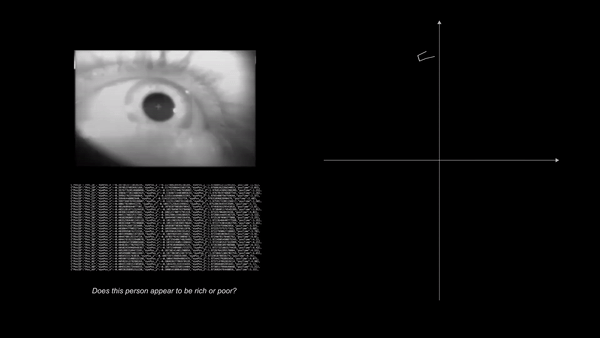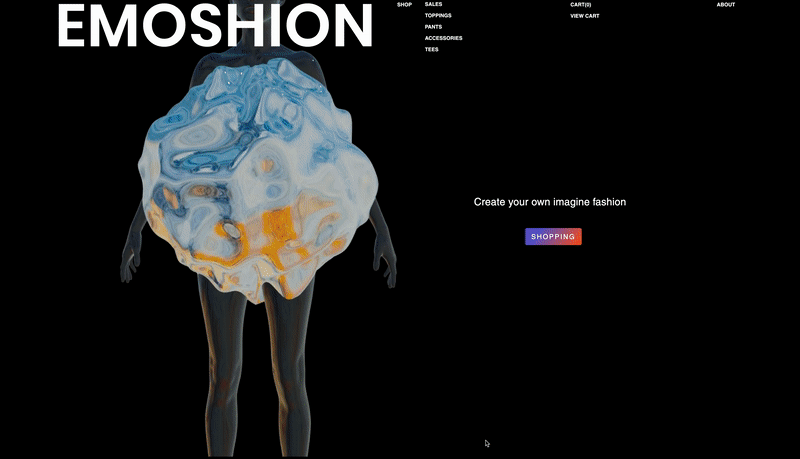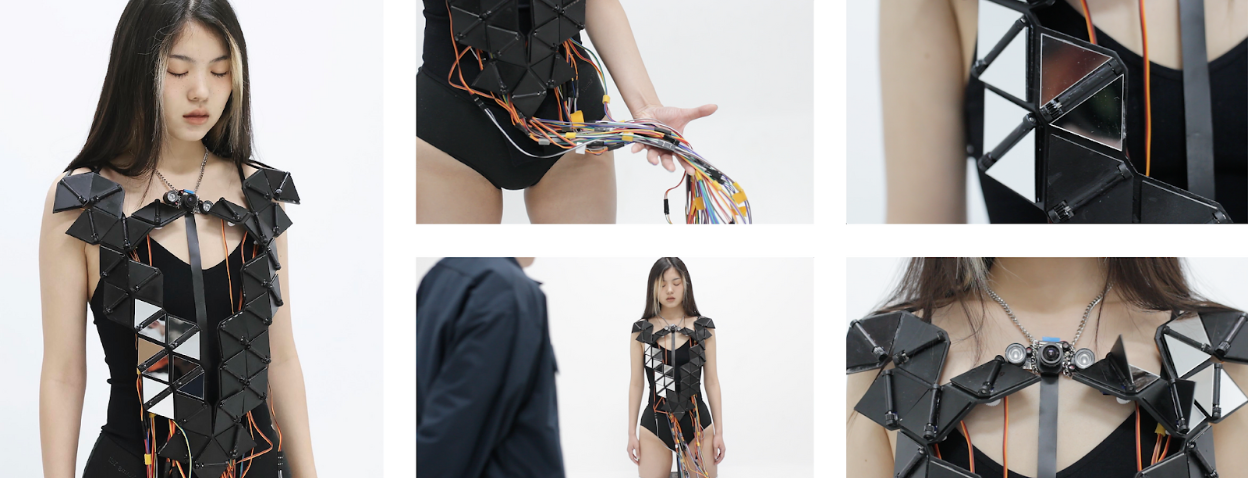
Melting points 2022, interactive wearable Installation
Vexing Veil
an Interview with artist Koi Ren
March 23rd, 2023
Koi Ren
Koi Ren is a creative thinker interested in creating an experience at the intersection between humans, society, science, and technology. She works with body and data, to generate tangible wearable devices and immersive digital experiences that borrow facets from nuance interactive between people, technology ethics, media theory, and feminism. She leverages technical engineering skills and unique artistic perspectives to execute interactive emerging technology projects with the medium of wearable, AR/VR, performance, and installation. Koi Ren is a Digital Insight Innovator at Nike Explore Team. She graduated from UC Berkeley Master of Design program, human-computer interaction and Graduate Certificate in New Media.

Emoshion 2021, real-time data digital fashion
"Vexing Veil" combines various forms of art. How do you integrate these different forms of art together?
I really like to try new things. Technology itself is something that is relevant to our time, and the process of learning technology is about understanding the extension of human will. In Chinese philosophy, "the vessels are preserved and the Way is not lost." The important thing is not the contents of the vessel, but the meaning of its existence. By combining different forms of art and media through meaning, they can be brought together and given life through the Way.
Can you tell us about your creative process? How do you come up with the concepts for your works? It seems like you are exploring a wide range of themes, from issues of social justice to the relationship between humans and nature.
I think this question is very interesting! Because at the beginning, making art was just a sudden inspiration and coincidence for me. As a high school student with a background in science and technology, I never thought that art was something I liked. But through the practice of chance, I found that my creativity was also making me reflect on myself. In the process of making my work, I feel like my understanding of myself emerges, as well as my insights into the world. For example, regarding my series on gaze, it was initially just my intuitive experience from my life, but through reading and researching philosophical ideas about gaze theory, I incorporated my own experiences and emotions into the work. So the formation of the concept for my work is the result of integrating theoretical concepts with personal experience, which is the combination of knowledge and perception.
Your "Vexing Veil" exhibition includes various forms of digital art, from real-time data NFTs to interactive wearable devices and multimedia performances. How do you think the combination of art and technology will affect the future of the art world?
The medium will change people's brains and modes of thinking. I think the interesting thing is how we can understand the medium before technology happens. In the division of labor in society, scientists are responsible for expanding the possibilities of technology itself, while designers are responsible for building bridges between humans and technological applications. And I hope that my art projects can become channels for building awareness of technology. It's like some subtle media can change people's behavior unconsciously. For example, when people decide what to eat, the first thing they do is take out their phone to look it up. This process is not entirely decided by the human brain, but by technology and artificial intelligence to assist people in making decisions. I hope that new media art can generate more awareness and innovation in the world of technology and media.

One of your works in the exhibition, "The Gaze through the Second Sex, 2021", explores power differences in the act of gazing. Can you talk about the concept behind this piece and how you hope it will guide the audience to think about gender and identity issues? In "Melting Points, 2022", you use interactive wearable devices to allow the audience to reexamine power relationships in gazing. How do you think art should influence people's perspectives and ways of thinking?
In your series of works on gazing, you explore how people shape power relationships and display desire and judgment as a visual society. The "panopticon theory" is particularly interesting, where a prisoner stands in a circular prison in the light, feeling the dark gaze of those around them. It is a social metaphor that everyone experiences, about how people constantly imitate themselves in society. We are both the self we imagine ourselves to be and the self we imagine others see us as, as well as the self we hope to be. Countless selves create self-awareness and conflicting emotions: a desire to be seen, but also a fear of being seen, and a reshaping of the self in the gaze environment. Like Foucault and Lacan's different views on gazing, the former believes that gazing behavior is a power relationship, and the gazing subject has absolute power; the latter believes that gazing behavior reflects the subject's desire and weakens the subject's power. In "The Gaze through the Second Sex", you explore the relationship between gender and gazing power, referencing the topic of the "male gaze" in film theory and showcasing the narcissistic emotions in gazing. When people look at others, they are also looking at themselves. In the "Melting Points" work, I collected 30-50 sets of gazing data in a garage, analyzed the data, and generated a heat map for "gaze judgment." The experimental subjects wore Hololens AR glasses and were asked four questions, such as "Is this person appear to be beautiful or ugly?" During the experiment, I also felt a sense of scrutiny. It made me reflect on some awkward moments when people are being gazed at in social life, and the social scrutiny constructed based on this.
In your work "Emoshion, 2021", real-time emotional data is transformed into dynamic and flowing digital clothing, emphasizing personal expression and digital identity. How do you view the relationship between technology and fashion in future development, and the role of digital art in this transformation? Your work often involves the combination of technology and fashion. How do you think digital fashion will develop in the future?
Digital fashion is interesting because it constructs an augmented reality through information media, allowing people to display themselves and create relationships. Digital fashion is not limited to wearables, and even an emoji could become digital fashion. The relationship between symbols and the body will be reconstructed in digital fashion. It feels like there will be an integration of digital media and the physical. It's a bit like the concept of IoT, but in reverse, redefining the body in digital media.
In your works, you often use biosensors and data visualization technology to allow viewers to gain a deeper understanding of the connection between humans and the natural world. How do you see the role of technology in art, and how do you turn complex scientific concepts into visually appealing art?
When I first entered the field of technology art, I encountered two very different directions. The first is to use technology to provide the possibility of interactive art, presenting results that cannot be achieved through traditional media, which is result-oriented. The second direction is to discuss the possibilities and changes brought about by the medium itself, which is media studies. "Second Gaze" and "Melting Points" belong to the former, using eye-tracking technology to present and discover some concepts about visual landscapes that we have in society, and to explore philosophical concepts and scientific insights about gaze in the work; while other works belong to the latter, discussing the possibilities and changes brought about by biosensors as a medium for human interaction with the outside world.
I personally think that both directions of research are very interesting. In terms of media studies, McLuhan's concepts of hot and cold media, as well as the idea of media as an extension of human organs and consciousness, remind us that technological media can completely influence individual thinking and collective behavior. What is important is not the information carried by the medium, but the meaning of the medium itself to human society. For example, the significance of biosensors, in specific cases, is essentially a form of communication and broadcasting. But how human communication is involved in data, how and why to quantify perception, is to use breakpoints, segmentation, and discrete methods to enhance people's organs and consciousness. When your consciousness is not just a vague feeling, but can be described as precise, discrete data, with three directions of x, y, and z axes, human sensory organs will face unprecedented challenges.
In fact, this trend can be found from various aspects of society. For example, divorce is a typical social case. When both parties in a divorce stand in court, people measure right and wrong and family contribution ratio in order to divide property. On the one hand, it is conducive to fairness and social efficiency, but is it possible to quantify and discretize relationships? Therefore, quantification inevitably leads to pixel degradation and resolution degradation. In the process of compression, some vague details are omitted, and only the results are left in a crude manner, which is also one of the products of our information age. But the good thing is that the more vague something is, the more infinite space it has to give participants, which is what McLuhan calls the cold medium. Because of the high degree of abstraction, it empowers participants with a high degree of possibility.

Hexen 2023, Installation + Performance
Regarding the possibility of quantifying emotions, could you discuss how you address the role of data in your work?
In the field of human-computer interaction, there are two factions regarding emotional quantification. The first faction is dedicated to using more advanced algorithms to obtain more accurate descriptions of people's emotions, such as facial recognition in computer vision and biosensors. The second faction discusses how to establish new connections and possibilities through technology under the premise that technology can never accurately describe emotions. People's emotions are extremely complex, and there is no accurate and unified model of emotions scientifically. Some people have even suggested that innovation ability is related to people's emotional systems. Personally, I am very interested in the theoretical research of the second faction. Since technology can never accurately describe emotions, is it possible for it to construct some possibilities based on human interaction? This is a clear and fuzzy game, in which people can reshape relationships and connections between people in the game. Especially in practical application scenarios, such as the "emoshion" project, when people are skeptical about wearing digital fashion that displays emotions, but in virtual social scenes in the metaverse, where there is a lack of emotional connection to reality, the emergence of emotion-wearable technology can help people establish another set of empathy and communication norms.
Your works often involve identity and gender issues. How do you think art should promote discussions and reflections on these issues in society?
Art, as a medium of information in society, will inevitably undergo some abstraction and simplification, and the information that can be conveyed will be relatively fragmented. However, perhaps what is important is that there are people in the world conveying their own experiences, and only their abilities can convey their experiences and reflections. For example, "Hexen" is more based on my personal experience of how people misunderstand, fear, and worship women, as well as women's self-attribution and social conditioning. Using a narrative approach to infect emotions and convey content expression.
Your works often use interactive and wearable technology to involve the audience in the creative process of the work. How do you think the interaction and co-creation between the audience and the artist affect the development of art?
This is also a flow of power. The emergence of NFTs is a transformation of the art market from centralization to mass media. This is also a process of transformation from hot media to cold media, which is an inevitable product of the digital age. When high-participation media is added to art, it is a magical process to reconstruct communication and empathy experiences.

Installation shot
Your work ":lepus" is a real-time data NFT project that explores the connection between humans and the natural world using bio-sensors and visual representation. The work uses transparent biological images to represent the inner world of humans, emphasizing transparency and the fragility and danger of the deepest parts of our being. What insights do you think this representation of transparency in your work offers for contemporary society?
Regarding the extension and castration of bio-sensors, if technology is an extension of humans and external organs of the body, then fashion is to some extent an extension of human expression. Therefore, any medium or work related to self-expression can be called fashion. If we carefully study the organs that humans possess, we will find that we have hearing, vision, touch, and muscles. The first three are ways of receiving information, equivalent to sensors, and the last one is the channel through which people express themselves. The billions of cells in our body and the complex thinking system are transmitted through muscle changes (speaking through throat muscles, facial expressions, and actions). This process is essentially a process of compression and reduction in clarity. Each person is trapped inside their own body, constantly receiving countless information, but the information that can be conveyed by the body alone is too limited. So I often wonder, how did humans start to express themselves through wearable technology, to represent themselves through a leaf, and to enhance themselves through visual means? It's such a clever thing! Perhaps it is for this reason that I am very interested in fashion/wearable technology, which is a channel for internal externalization and an attempt to establish a channel with others. However, at the same time, technology and visual means are also amputating "self", and no matter how much expression there is, it is ultimately compressed, castrated, and narcissistic. I think this contradiction is very attractive in fashion itself, with a romanticism of self-destructiveness.

